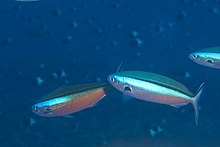Dark-banded fusilier
| Dark-banded fusilier | |
|---|---|

| |
| Scientific classification | |
| Domain: | Eukaryota |
| Kingdom: | Animalia |
| Phylum: | Chordata |
| Class: | Actinopterygii |
| Order: | Perciformes |
| Family: | Caesionidae |
| Genus: | Pterocaesio |
| Species: | P. tile
|
| Binomial name | |
| Pterocaesio tile (Cuvier, 1830)
| |
| Synonyms[2] | |
| |
The dark-banded fusilier (Pterocaesio tile), also known as blue-streak fusilier, bluedash fusilier, or neon fusilier, is a species of marine ray-finned fish, a fusilier belonging to the family Caesionidae. It has a wide Indo-West Pacific range. It is of some importance to fisheries within its range.
Taxonomy
The dark-banded fusilier was first formally described as Caesio tile in 1830 by the French zoologist Georges Cuvier with the type locality given as the Caroline Islands.[3] When the Dutch ichthyologist Pieter Bleeker described Pterocaesio as a new genus in 1876 he used Caesio multiradiatus, a species described by the Austrian ichthyologist Franz Steindachner in 1861, as the type species. C. multiradiatus was subsequently considered to be a synonym of Cuvier's C. tile.[4] Kent E. Carpenter placed this species in the monospecific subgenus Pterocaesio in his review of the Caesionidae of 1987.[5] The specific name tile is the local name for this species in the Caroline Islands.[6]
Description
P. tile can reach a length of 25 cm (9.8 in). The back of the body is dark blue, while the flanks show a bluish-green strike with a black stripe along the lateral line. The lower third of the body varies from white to pinkish. The lower half of the body turns bright red at night (hence the common name neon fusilier). It is oviparous and not migratory; it feeds on zooplankton.[7]
Distribution and habitat
This species is widespread in Indo-Pacific, from East Africa to the Tuamoto Islands, southern Japan, Mauritius, and the Austral Islands. P. tile is a coral-reef associated species. It usually can be found in lagoon and on the reef flats at depths to 60 m (200 ft).
References
- ^ Carpenter, K.E.; Lawrence, A. & Myers, R. (2016). "Pterocaesio tile". IUCN Red List of Threatened Species. 2016: e.T20253151A65927672. doi:10.2305/IUCN.UK.2016-3.RLTS.T20253151A65927672.en. Retrieved 6 July 2021.
- ^ Froese, Rainer; Pauly, Daniel (eds.) (2021). "Pterocaesio tile" in FishBase. June 2021 version.
- ^ Eschmeyer, William N.; Fricke, Ron & van der Laan, Richard (eds.). "Species in the genus Pterocaesio". Catalog of Fishes. California Academy of Sciences. Retrieved 6 June 2021.
- ^ Eschmeyer, William N.; Fricke, Ron & van der Laan, Richard (eds.). "Genera in the family Lutjanidae". Catalog of Fishes. California Academy of Sciences. Retrieved 6 July 2021.
- ^ Cite error: The named reference
Carpenterwas invoked but never defined (see the help page). - ^ Christopher Scharpf & Kenneth J. Lazara, eds. (5 January 2021). "Order LUTJANIFORMES: Families HAEMULIDAE and LUTJANIDAE". The ETYFish Project Fish Name Etymology Database. Christopher Scharpf and Kenneth J. Lazara. Retrieved 6 July 2021.
- ^ Carpenter K.E. (1988) FAO Species Catalogue: Vol 8: Fusilier fishes of the world Unipub. ISBN 978-92-5-102746-2.
External links
- Photos of Dark-banded fusilier on Sealife Collection

